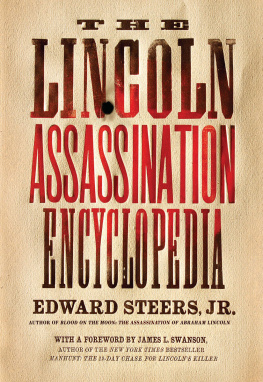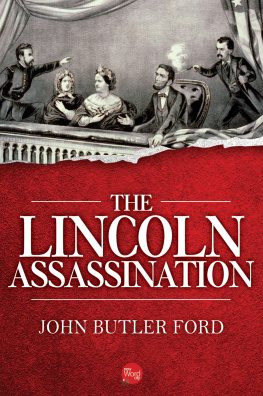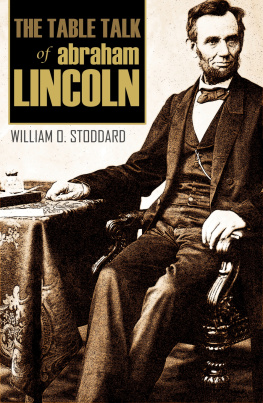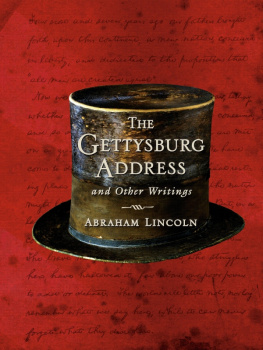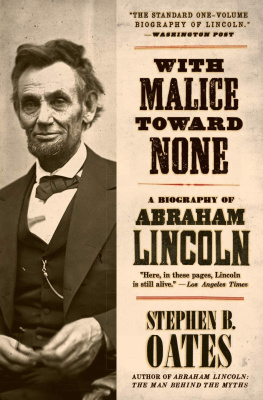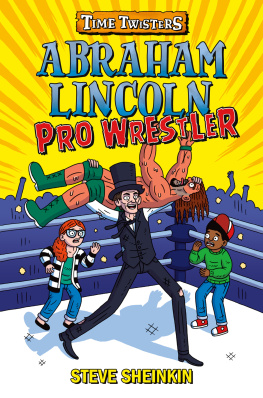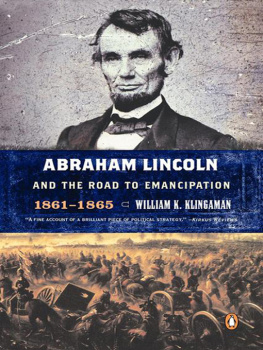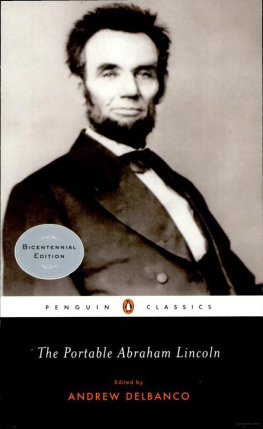This work is dedicated to my wife, Pat, who makes it all worthwhile.
Funny how life just falls into place somehow.
T he assassination of President Abraham Lincoln on April 14, 1865, was one of the most dramatic and haunting passages in American history. While Lincoln and John Wilkes Booth will be remembered forever for their starring roles, a cast of hundreds played essential supporting parts in determining exactly how events unfolded. These include doctors, conspirators, detectives, stage actors, generals, spies, and former slaves, among many more who were swept up by the tragedy. Indeed, most of the people and places that made the events of April 1865 so compelling have been lost to popular memory. Their names live only in the thousands of obscure documents, books, and transcripts that now lie scattered beyond the reach of Google, buried in libraries and private collections across the country.
Lincoln enthusiasts and students of his assassination have long awaited the publication of Edward Steers, Jr.s, Lincoln Assassination Encyclopedia . Here, at last, is the definitive resource on the subject, written by the foremost expert on the conspiracy and murder. Never before has an author gathered all the characters, places, events, and miscellaneous facts in a single work. Moreover, rarely has a scholar so skillfully executed a reference project of any kind. I can quite easily say that this is an indispensible book I wish I had in my hands when I researched and wrote Manhunt: The 12-Day Chase for Lincolns Killer . It will become a valuable companion to readers of Manhunt, or any book about Lincoln or Booth.
Through Steerss clear prose and judicious cross references, one can easily understand how any of the many minor players fit into the bigger picture. It is fascinating to explore the book, for each entry, no matter how small, leads to another and another, gradually illuminating the entire drama. Steers even addresses the numerous colorful myths, hoaxes, and controversies that have emerged over timesee his Booth mummy entry, for instance. Further, the Encyclopedia s comprehensive introduction and useful timeline provide a firm footing from which any reader can begin an exploration of the events. Without Edward Steerss invaluable one-stop source for everything and anything pertaining to the assassination, one might have to search for hours through dozens of books, many of them rare and difficult to find. In addition to its scholarly contributions, it will become clear to anyone who dips into its pages that The Lincoln Assassination Encyclopedia is a splendid readan expertly guided adventure through one of historys richest and saddest chapters. Anyone interested in the life and death of our greatest president must have this book.
O n the evening of April 14, 1865, Abraham Lincoln decided to take a respite from the pressing duties of the presidency and visit Fords Theatre to see a rollicking comedy titled Our American Cousin . Although fighting was still taking place, nearly everyone knew it was only a matter of days before the bloodiest conflict in American history would finally come to an end. Among the few who continued to cling to the hope of Confederate independence was John Wilkes Booth, an actor of star quality whose love of the Confederacy led him to give up his illustrious career on the American stage for a far greater role, the assassin of Abraham Lincoln.
On May 28, 1864, Booth gave his last paid performance and embarked on a mission to capture the president and present him to the authorities in Richmond, Virginia, as a bargaining chip in the exchange of Confederate prisoners of war.
On learning that President Lincoln and General Ulysses S. Grant would attend Fords Theatre on the evening of April 14, Booth met with three members of his team to go over his decisive & great plan to save the Confederacy. Meeting at a boardinghouse located two blocks from the theater, Booth assigned Lewis Thornton Powell the task of murdering Secretary of State William H. Seward, and to George Andrew Atzerodt the job of murdering Vice President Andrew Johnson. He would leave the murder of President Lincoln to his own hand, thus ensuring that the honor for ridding the nation of a terrible tyrant would fall on his shoulders alone.
While Booth left two lengthy letters explaining why the president did not deserve to live and should be killed, he did not explain what he hoped to accomplish by killing the president, vice president, and secretary of state. We can only guess at his reasoning from the writings he left. By decapitating the Federal government, Booth hoped to create chaos within it and thereby allow the beleaguered Confederacy time to gather her scattered troops into a cohesive fighting unit and turn them against Grant and the North, thereby forcing a negotiated peace. Booths objective was unrealistic, but to some in the rapidly sinking Confederacy, it provided the only hope left for gaining independence.
Shortly after nine oclock on the evening of Friday, April 14, Booth walked his horse up the alley leading to the rear door of the theater. Opening the door, Booth quietly called for Edman Spangler to come outside to hold his horse. Spangler, a longtime friend of Booths, protested, telling Booth he had to shift scenes between acts. Booth told Spangler he would only be a few minutes and quietly slipped into the backstage area, leaving Spangler holding the horses reins. Spangler turned the reins over to Peanut John, a helper of sorts around the theater whose main job was guarding the stage door from unauthorized use during performances. Peanut John took the reins and stretched out on a bench near the rear door to rest. He knew Mr. Booth was an important man and that he best do as he was told.
Entering the backstage area, Booth lifted a trapdoor that led to a dugout cellar beneath the stage. Passing under the stage to the opposite side, he ascended a second set of stairs and emerged through a second trapdoor. Booth was able to move from one side of the stage area to the other without being noticed or interfering with the play. He then exited through the stage door into a narrow passageway that opened onto Tenth Street and the front entrance to the theater. Because of his knowledge of the theater, Booth was able to leave his horse safely behind the theater while he entered through the front door, into the theater lobby. Booth made his way up the stairs that led from the lobby to the balcony known as the Dress Circle. Making his way across the rear of the Dress Circle, he approached the door leading to the presidential box.
Only one person stood between Booth and the door: Charles Forbes, the presidents valet and messenger. Forbes had accompanied the president and his party to the theater. After the president had entered the theater, Forbes had followed behind, climbing the stairs to the Dress Circle, where he took a seat at the end of the row placing him closest to the outer door of the presidential box. Forbes was not a policeman and had no duties involving the presidents personal safety.
Booth paused for several seconds as he stood next to Forbes. He took a small card from his vest pocket and handed it to Forbes. Forbes glanced at the card and waved Booth into the box. Lincolns skull. The president went limp, his head bent forward with his chin resting on his chest.

The moment of assassination
Authors collection
Realizing someone had been shot in the presidents box, a young army surgeon by the name of Charles Leale rushed from his seat in the Dress Circle and entered the box once the wedge had been removed. Examining the comatose president, Leale concluded that the wound was mortal and the president had little time to live. Attended by Leale and several others, Lincoln was carried across the street to the house of a tailor named Petersen, where he was taken to a rear bedroom rented by a young soldier working as a clerk in the Quartermasters Department.

